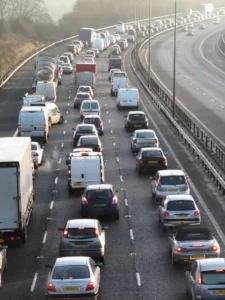The increasing backlog in road maintenance work is hindering local authorities in undertaking preventative work that could deliver better value for money, according to a National Audit Office report.
The report, The condition and maintenance of local roads in England*, said that: “Despite their importance, the condition of local roads is declining and the backlog to return them to a good state of repair is increasing.”
It said that it was ‘essential’ that the Department for Transport (DfT) derives ‘maximum’ value from the funding it has available.
DfT has provided between £1.1bn and £1.6bn of capital funding each year to local authorities and has set out plans for additional funding through to 2034.
The report also said that the DfT was lacking certain crucial information on the state of the network. “At present DfT does not have a good enough understanding of the condition of local roads, and does not use the limited data it does have to allocate its funding as effectively as possible. It does not know whether the funds it allocates are delivering improvements in road condition, and has not updated its guidance to local authorities, to share good practice and help them make the most of their limited funds, for some years.”
But it added that manging the local road network was becoming ‘increasingly complex’. It said that climate change and autonomous vehicles demand more from it – and the additional funding that DfT has secured provides an opportunity to equip local authorities to better meet these challenges.
“If DfT is able to address the issues in its current approach, it will be much better placed to improve the value for money of funding in this area and secure an improved and more resilient local roads network.”
In 2019 the Department for Transport (DfT) estimated the cost to address the backlog in local road maintenance as between £7.6bn and £11.7bn. In 2023/24, industry estimates put the backlog at £15.6bn, based on the ALARM survey.
According to the NAO: “There are currently significant gaps in DfT’s information on the condition of local roads, limiting its understanding of condition of the network. DfT requires local authorities to report the proportion of their road networks that should be considered for maintenance each year, based on a survey of a portion of the network. Local authorities do not provide all the data that DfT mandates – for example, one fifth of authorities did not share data on the proportion of their A roads that should be considered for maintenance in 2023.”
DfT plans to increase the response rate of local authorities by working with them more closely and recruiting a dedicated DfT specialist for road condition data collection. There is no reporting requirement for unclassified roads, which make up 62% of the local network, although around 70% of local authorities provided these data in 2023. This means DfT does not hold information for much of the network. DfT told us that it decided to limit the data it collects from local authorities to minimise administrative burdens (for local authorities), according to the report.
The limited data that DfT does collect show the surface condition of local roads as stable over time, but information from industry bodies and people using roads suggests that road condition is getting worse, the NAO report said.
“DfT’s latest data on road surface condition show that around two-thirds (67% in 2022-23) of total local road network length was in good condition. However,the ALARM survey shows only half of roads (48% in 2023/24) to be in good structural condition, and that this has been largely consistent since 2015/16. Research undertaken in 2021 by the UK Roads Leadership Group – a body chaired by DfT, but whose members come from national and local government – found the condition of the network was deteriorating.”
Recommendations made by the NAO to the DfT include:
- Review its approach to allocating capital funding to local authorities for local road maintenance to ensure its allocative effectiveness.
- Work with the Treasury to set out how it will provide longer-term funding certainty to local authorities that will help better support preventative road maintenance approaches.
- Update its use of incentivised funding and consider how it could use this to improve outcomes.
Paul Boss, RSTA CEO said “The NAO report and recommendations have highlighted what the association has been calling for the last 4 years. Cost effective low carbon preventative maintenance is being stifled by the overall poor condition of roads, and a lack of guidance and clarity from DfT regarding use of preventative treatments to attain a cost effective, sustainable lifecycle for maintenance of highway assets.
“The incentivised funding questionnaire was due for review in 2020, and whilst the Covid 19 pandemic and other unfortunate issues delayed this, we are now in 2024, and no reviewed or new incentivisation process has been developed. To their credit, the DfT did review and increase the treatments covered by their ‘work completed’ return that all local roads authorities have to complete each year. It now includes all preventative maintenance treatments and Insitu-recycling, saving costs and carbon, even when roads require reconstruction,” Mr Boss added.
“The completed and submitted works completed returns have already begun to highlight those authorities that are not implementing proactive sustainable preventative maintenance policies, despite having declared climate emergencies over the last 4 – 6 years. This proxy for incentivised funding now needs to be combined with a new incentivised funding process and questionnaire, the results of which need to be independently audited each year,” he went on to say.
Also responding to the report, Asphalt Industry Alliance chair David Giles said: “The results of the National Audit Office report clearly echo those of our Annual Local Authority Road Maintenance (ALARM) survey reports across the years and confirm what we already know – the condition of our local roads is now at an all-time low and there are significant challenges ahead if we are to see significant improvements.
“The report consistently refers to the results of our ALARM survey, highlighting its importance as a credible source of data, and the AIA welcomed the opportunity to provide information for review in this process.
“The NAO report makes some strong recommendations for how the DfT can help improve its understanding of the condition of the network in England, its approach to funding and its support and guidance for local authorities to help them deliver effective and efficient highways maintenance.
“We stand by the calls made in our 2024 ALARM survey report for sustained, targeted and accountable funding for local roads, which are complementary to those NAO recommendations. Without clarity on how much money will be made available over the life of this Parliament, as well as an effective ring-fence mechanism, local authorities will be unable to carry out the proactive maintenance required to improve conditions for the benefit of all road users.
“Swift action needs to be taken and we look forward to working with the new ministerial team at the DfT to support efforts to improve local road conditions and address the £14.4bn carriageway maintenance backlog reported in England in this year’s ALARM survey.”
PIC-RAC























